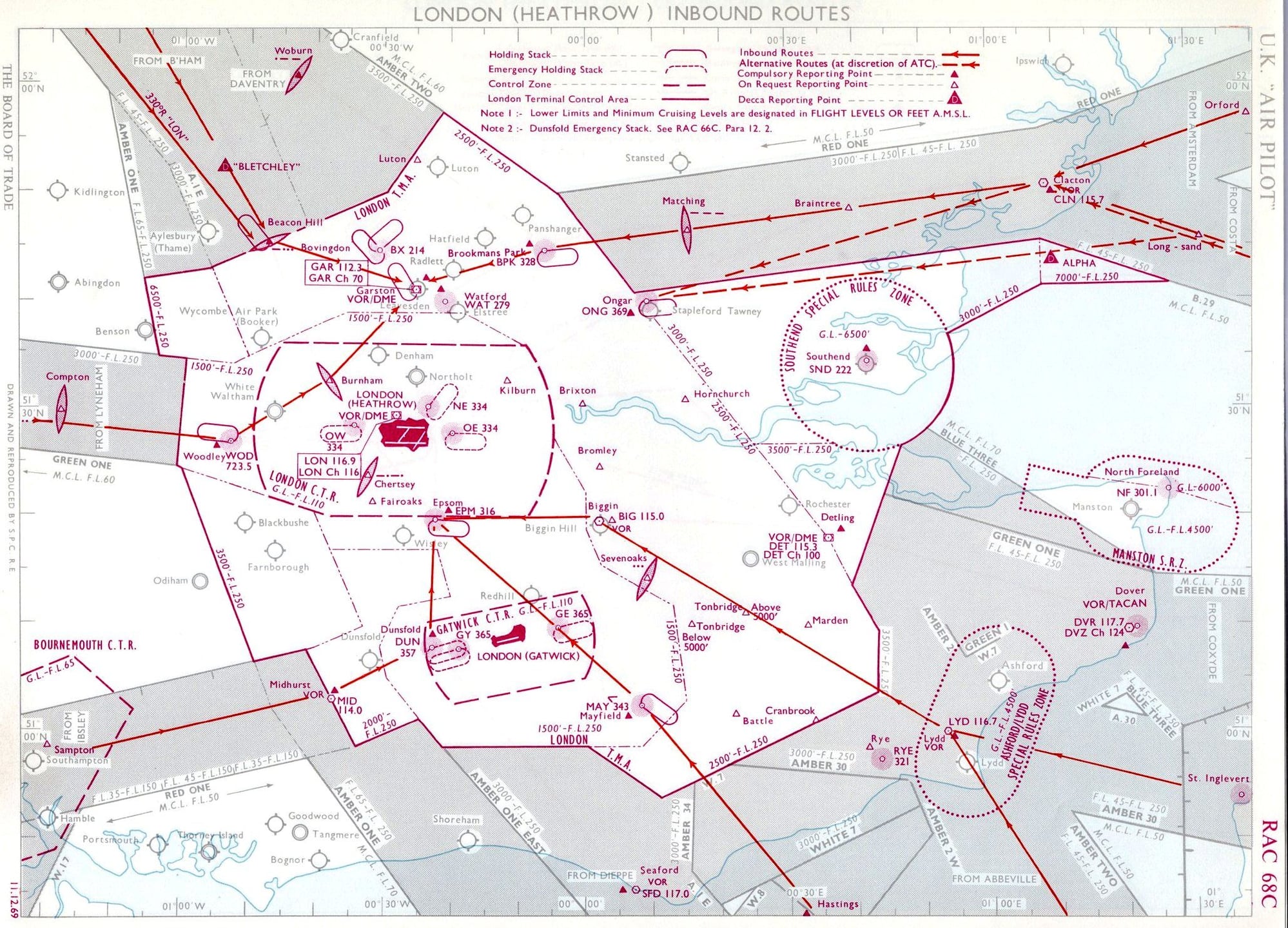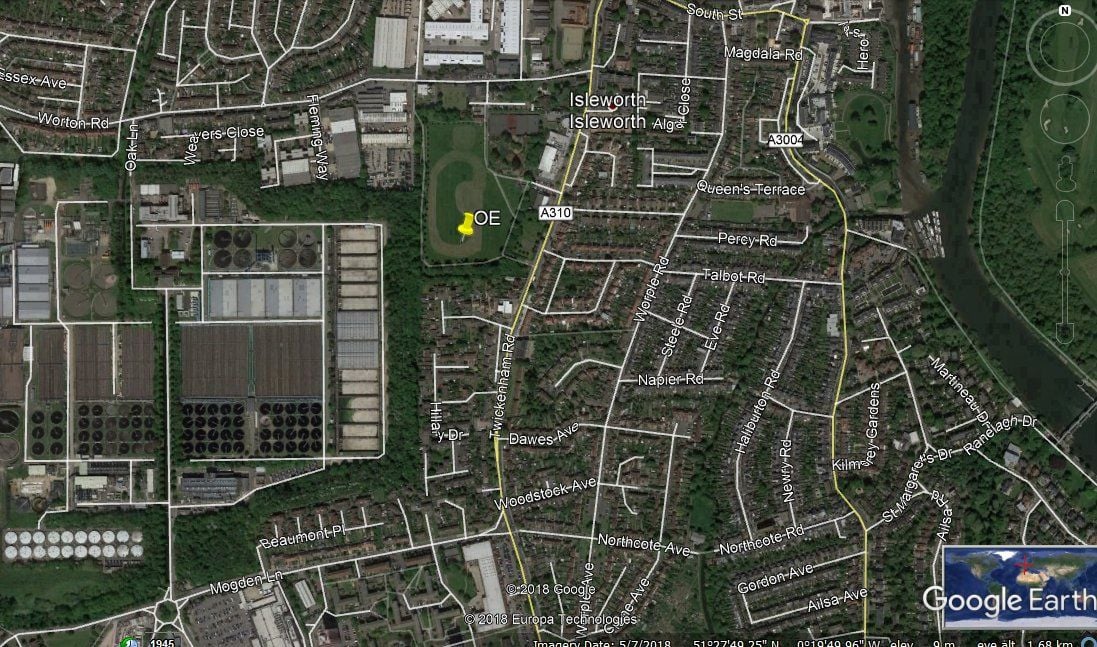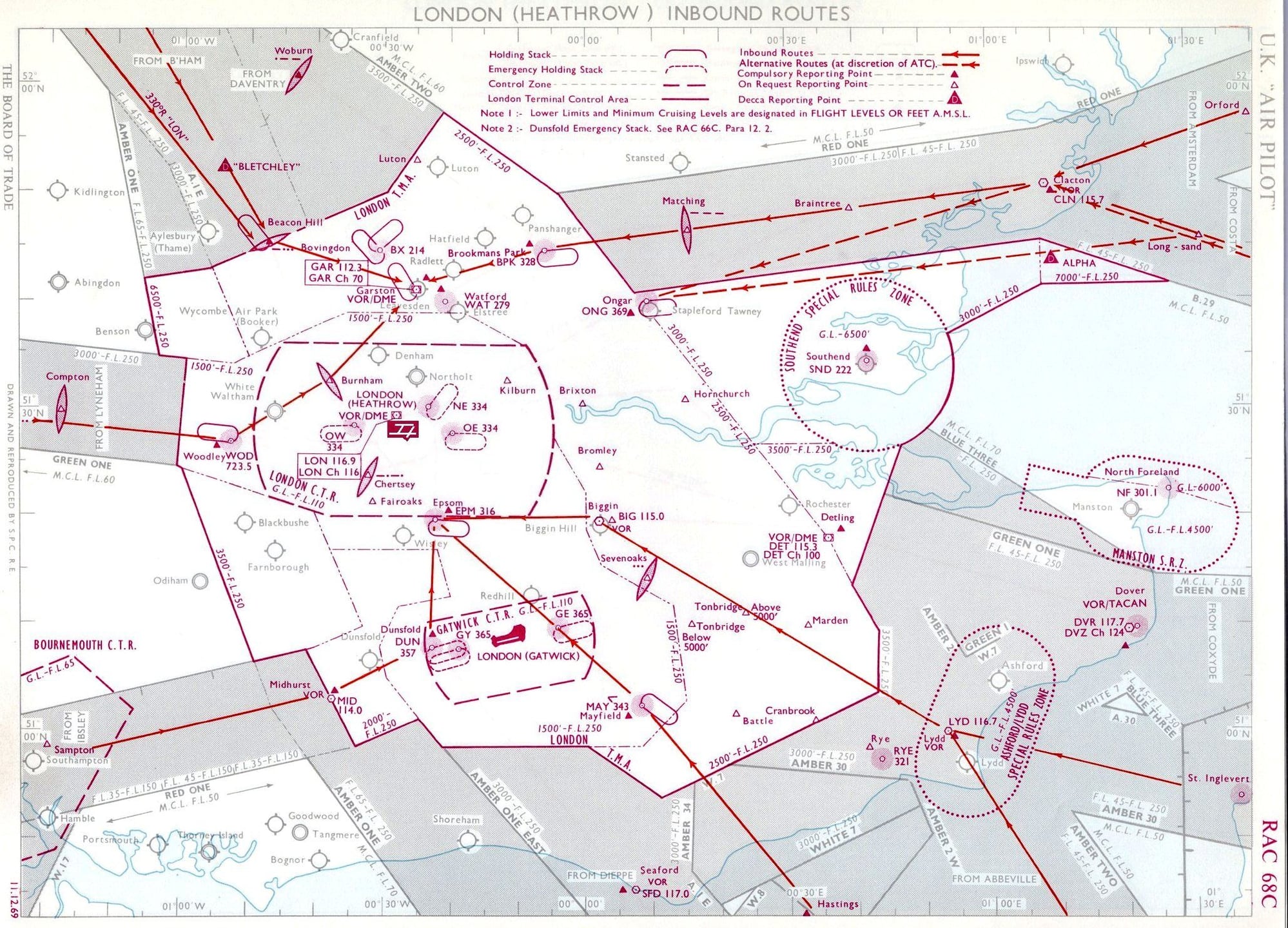LHR nostalgia
A postscript to the discussion on the final closure of 05L/23R - the excellent Bish/Piket history of LHR ATC bundles together the works at the end of the 1960s to prepare for the introduction of the 747.
These included the extension of 10L/28R, the T3 Arrivals building and Pier 7
Pier 7, which I believe was completed by the time Pan Am's 747 services to LHR started in January 1970, lies along the line of the former 15R/33L and would also have necessitated the closure of 05L/23R due to its proximity.
Incidentally, Heathrow's current control tower also lies on the line of the old runway.
Perhaps a silly question, but if the KLM was on a LH downwind, could it not equally have been for 05R ?
These included the extension of 10L/28R, the T3 Arrivals building and Pier 7
Pier 7, which I believe was completed by the time Pan Am's 747 services to LHR started in January 1970, lies along the line of the former 15R/33L and would also have necessitated the closure of 05L/23R due to its proximity.
Incidentally, Heathrow's current control tower also lies on the line of the old runway.
Perhaps a silly question, but if the KLM was on a LH downwind, could it not equally have been for 05R ?
Join Date: Jan 2004
Location: England
Posts: 762
Likes: 0
Received 0 Likes
on
0 Posts
I remember 05/23 being resurfaced in 1991/2 period ? It was always interesting to watch when 23 was in use for landing in strong S to SW winds. A few aircraft preferred the longer runway 27L which gave ATC the challenge of trying to work out if separation could be maintained during landing between an arrival on 23 against an arrival on 27L where the headwinds and therefore ground speeds were very different. Also the opening of T4 (April 1986 I believe) and the close proximity of runway 05/23 was not ideal operationally. A week or so before T4 opened runway 05 was in use due strong NE winds and everyone was thinking "I hope this doesn't happen after T4 opens".
Join Date: Aug 2007
Location: USA
Posts: 58
Likes: 0
Received 0 Likes
on
0 Posts
Pier 7 may have been completed... but the airbridges weren't! I flew out on a TWA 747 in December 1970 and had to walk to the aircraft and climb an incredibly high set of steps. Ahh, what a great way to board the Queen of the Skies.
A postscript to the discussion on the final closure of 05L/23R - the excellent Bish/Piket history of LHR ATC bundles together the works at the end of the 1960s to prepare for the introduction of the 747.
These included the extension of 10L/28R, the T3 Arrivals building and Pier 7
Pier 7, which I believe was completed by the time Pan Am's 747 services to LHR started in January 1970, lies along the line of the former 15R/33L and would also have necessitated the closure of 05L/23R due to its proximity.
Incidentally, Heathrow's current control tower also lies on the line of the old runway.
Perhaps a silly question, but if the KLM was on a LH downwind, could it not equally have been for 05R ?
These included the extension of 10L/28R, the T3 Arrivals building and Pier 7
Pier 7, which I believe was completed by the time Pan Am's 747 services to LHR started in January 1970, lies along the line of the former 15R/33L and would also have necessitated the closure of 05L/23R due to its proximity.
Incidentally, Heathrow's current control tower also lies on the line of the old runway.
Perhaps a silly question, but if the KLM was on a LH downwind, could it not equally have been for 05R ?
Thread Starter
LHR inbound routes in 1969:

Some interesting points:
- the position of the 'OE' beacon is incorrectly shown as lying between the approach paths of 28L/R; in fact it was aligned with the 28L approach.
- ditto for the 'NE' beacon; it was aligned with the 23L approach
- navigation along Green 1 was difficult - the WOD beacon was displaced south of the centreline and there were no beacons defining the centreline (the Lyneham NDB was also offset) until the airway intercepted a specific Brecon VOR radial to the northeast of Bristol - pilots referred to this point as 'the bend'
- the base of the TMA was only 1500 ft in the WOD area - presumably to cater for the less than sparkling climb performance of some airliner types in those days

Some interesting points:
- the position of the 'OE' beacon is incorrectly shown as lying between the approach paths of 28L/R; in fact it was aligned with the 28L approach.
- ditto for the 'NE' beacon; it was aligned with the 23L approach
- navigation along Green 1 was difficult - the WOD beacon was displaced south of the centreline and there were no beacons defining the centreline (the Lyneham NDB was also offset) until the airway intercepted a specific Brecon VOR radial to the northeast of Bristol - pilots referred to this point as 'the bend'
- the base of the TMA was only 1500 ft in the WOD area - presumably to cater for the less than sparkling climb performance of some airliner types in those days

Last edited by DaveReidUK; 7th Mar 2019 at 16:22.
My Dad used to work for a company called Stanley Hugh Leach who are still going to this day & he used to take me to work with him repairing the runways/taxiways in the late 1950’ early 1960’s & I am sure I was taken on an Avro York which was being broken up somewhere near the Queens building....... ended up as an Aircraft Engineer for a major airline so it certainly started my interest in aircraft.... still remember Heathrow having 4 runways!!
Still we could always build another terminal & another runway!!
Still we could always build another terminal & another runway!!
I used to live under the flightpath of 23L in the 60's through to the end of its use just after 2000 or so, and I don't ever recall seeing anything coming in on what would have been the flightpath into 23R in the 60's, also, this would have taken the a/c close to the Northolt gasholder into 23R, so I also doubt 23R was ever used for landings for some considerable time prior to closure?
So, was it take-offs only on 23R, and landings only on 23L prior to the closure of 23R...?
So, was it take-offs only on 23R, and landings only on 23L prior to the closure of 23R...?
On the chart "LHR inbound routes in 1969": the runway layout is drawn much enlarged and hence the NDB beacons don't line up with the runways but are in the correct position in relation to other items on the chart.
10L/28R is about 22,000 feet long according to the scale of the chart.

Thread Starter
Good spot dixi! Here's the precise location of the 'OE' NDB*, at the southern end of Redlees park, where as kids we used to play football and tennis. As noted by DRUK the beacon lay just to the east of the Mogden sewage works (whose fragrance we and our neighbours could detect in certain wind conditions).

*based on coordinates promulgated in UK AIP; accurate to within 30 metres
Amended version of inbound routes:


*based on coordinates promulgated in UK AIP; accurate to within 30 metres
Amended version of inbound routes:

Last edited by Discorde; 10th Mar 2019 at 18:55. Reason: Note on position accuracy added; amended chart added
Join Date: Sep 2011
Location: Heathrow
Posts: 66
Likes: 0
Received 0 Likes
on
0 Posts
Ah Redlees Park, Football, planes, Gumley House, Girls, not necessarily in that order :-), was this OE NDB a physical thing ? I don't remember seeing anything out of the ordinary lurking in the bushes back then?
Thread Starter
More snippets from the 1969 LHR AIP:
Pilots wishing to use the maximum possible take-off distance on Runway 28R must notify ATC (Extension 5100) and the London (Heathrow) Airport Constabulary (Extension 7555) 30 minutes before ETD to enable the perimeter road at the end of the clearway to be cleared of traffic.
Runways 28L/R will normally be used in preference to runways 10L/R when the tailwind component is no greater than 5 knots and the runway surface is dry.
When the associated cross-wind component on these main runways exceeds 12 knots, a runway more nearly into wind will normally be used.
When a westerly traffic flow is in operation, there will be a preferential use of 28L for landing and 28R for take-off. Operators should advise ATC in advance when operational considerations prevailing for a particular flight will require 28L for take-off.
Pilots are warned that the relative positions of the gasholders at Southall and South Harrow to Runway 23L at Heathrow and Runway 26 at Northolt, have on occasion caused confusion. The letters "LH" and an arrow pointing to Runway 23L at Heathrow are painted on the gasholder at Southall on its north-east side. The letters on the north-east side of the South Harrow gasholder are "NO" with an arrow pointing to Runway 26 at Northolt. Letters and arrows are in white and 30 feet high.
There is also a description of the Daylight Route Indicator (DRI) to assist pilots taxiing in daytime. Boards were situated adjacent to stop bars and showed correct routing using white lights on a black-and-white diagram of the nearby taxiways. My memory says that this system was withdrawn from service by 1972.
Pilots wishing to use the maximum possible take-off distance on Runway 28R must notify ATC (Extension 5100) and the London (Heathrow) Airport Constabulary (Extension 7555) 30 minutes before ETD to enable the perimeter road at the end of the clearway to be cleared of traffic.
Runways 28L/R will normally be used in preference to runways 10L/R when the tailwind component is no greater than 5 knots and the runway surface is dry.
When the associated cross-wind component on these main runways exceeds 12 knots, a runway more nearly into wind will normally be used.
When a westerly traffic flow is in operation, there will be a preferential use of 28L for landing and 28R for take-off. Operators should advise ATC in advance when operational considerations prevailing for a particular flight will require 28L for take-off.
Pilots are warned that the relative positions of the gasholders at Southall and South Harrow to Runway 23L at Heathrow and Runway 26 at Northolt, have on occasion caused confusion. The letters "LH" and an arrow pointing to Runway 23L at Heathrow are painted on the gasholder at Southall on its north-east side. The letters on the north-east side of the South Harrow gasholder are "NO" with an arrow pointing to Runway 26 at Northolt. Letters and arrows are in white and 30 feet high.
There is also a description of the Daylight Route Indicator (DRI) to assist pilots taxiing in daytime. Boards were situated adjacent to stop bars and showed correct routing using white lights on a black-and-white diagram of the nearby taxiways. My memory says that this system was withdrawn from service by 1972.
Join Date: Aug 2008
Location: UK
Posts: 28
Likes: 0
Received 0 Likes
on
0 Posts
More snippets from the 1969 LHR AIP:
Pilots wishing to use the maximum possible take-off distance on Runway 28R must notify ATC (Extension 5100) and the London (Heathrow) Airport Constabulary (Extension 7555) 30 minutes before ETD to enable the perimeter road at the end of the clearway to be cleared of traffic.
Runways 28L/R will normally be used in preference to runways 10L/R when the tailwind component is no greater than 5 knots and the runway surface is dry.
When the associated cross-wind component on these main runways exceeds 12 knots, a runway more nearly into wind will normally be used.
When a westerly traffic flow is in operation, there will be a preferential use of 28L for landing and 28R for take-off. Operators should advise ATC in advance when operational considerations prevailing for a particular flight will require 28L for take-off.
Pilots are warned that the relative positions of the gasholders at Southall and South Harrow to Runway 23L at Heathrow and Runway 26 at Northolt, have on occasion caused confusion. The letters "LH" and an arrow pointing to Runway 23L at Heathrow are painted on the gasholder at Southall on its north-east side. The letters on the north-east side of the South Harrow gasholder are "NO" with an arrow pointing to Runway 26 at Northolt. Letters and arrows are in white and 30 feet high.
There is also a description of the Daylight Route Indicator (DRI) to assist pilots taxiing in daytime. Boards were situated adjacent to stop bars and showed correct routing using white lights on a black-and-white diagram of the nearby taxiways. My memory says that this system was withdrawn from service by 1972.
Pilots wishing to use the maximum possible take-off distance on Runway 28R must notify ATC (Extension 5100) and the London (Heathrow) Airport Constabulary (Extension 7555) 30 minutes before ETD to enable the perimeter road at the end of the clearway to be cleared of traffic.
Runways 28L/R will normally be used in preference to runways 10L/R when the tailwind component is no greater than 5 knots and the runway surface is dry.
When the associated cross-wind component on these main runways exceeds 12 knots, a runway more nearly into wind will normally be used.
When a westerly traffic flow is in operation, there will be a preferential use of 28L for landing and 28R for take-off. Operators should advise ATC in advance when operational considerations prevailing for a particular flight will require 28L for take-off.
Pilots are warned that the relative positions of the gasholders at Southall and South Harrow to Runway 23L at Heathrow and Runway 26 at Northolt, have on occasion caused confusion. The letters "LH" and an arrow pointing to Runway 23L at Heathrow are painted on the gasholder at Southall on its north-east side. The letters on the north-east side of the South Harrow gasholder are "NO" with an arrow pointing to Runway 26 at Northolt. Letters and arrows are in white and 30 feet high.
There is also a description of the Daylight Route Indicator (DRI) to assist pilots taxiing in daytime. Boards were situated adjacent to stop bars and showed correct routing using white lights on a black-and-white diagram of the nearby taxiways. My memory says that this system was withdrawn from service by 1972.
Join Date: Aug 2008
Location: UK
Posts: 28
Likes: 0
Received 0 Likes
on
0 Posts
Growing up in Northolt I remember the occasional days when I could watch the heavies on finals for 23L from my bedroom window as a spotty 14 year-old. On one occasion I recall a BA 767 flying what looked to be an S pattern around the loc to put a bit of distance in to the one in front on a blustery day of s'westerlies. My airband radio was out of batteries so have no idea to what extent this would have been sanctioned.
Nearly 40 years on I'm at my mum's (dad passed on 3 years ago) for a visit looking out of the same window and reliving the innocence of those years. That included 7 mile bike rides to the airfield on hot Saturdays in the 1980s and whole days moping around the field. That included the smallholdings with chickens between the western ends of the runways where I suspect T5 or at least the car parks now are.
Much has changed. EGLL holds less fascination these days and I wonder whether it is at the start of a prolonged decline what with all the factors emerging from pandemic, market, politics, environment etc.
Thank you for this thread. Although my memories from the 1980s are less glamorous, they are precious to me, and it's a privilege to share them with others with similar remenisces.
Nearly 40 years on I'm at my mum's (dad passed on 3 years ago) for a visit looking out of the same window and reliving the innocence of those years. That included 7 mile bike rides to the airfield on hot Saturdays in the 1980s and whole days moping around the field. That included the smallholdings with chickens between the western ends of the runways where I suspect T5 or at least the car parks now are.
Much has changed. EGLL holds less fascination these days and I wonder whether it is at the start of a prolonged decline what with all the factors emerging from pandemic, market, politics, environment etc.
Thank you for this thread. Although my memories from the 1980s are less glamorous, they are precious to me, and it's a privilege to share them with others with similar remenisces.






